Myth Makers: Comic Creators On Black Panther - Part 2
Feb 25, 2018
In part one of our “Myth Makers” series, we kicked things off by asking the comic creators who helped build the legend of Black Panther what they think defines the character. We now continue with a look into the 1970s for a more expansive take. You can read part one HERE.
by Troy-Jeffrey Allen
Who is the Black Panther? Is he a king distracted by other-worldly escapades? A narrative proxy for 1960s black empowerment? Or maybe he’s an adventurer skulking through Wakandan greenery waiting for his moment to strike.
Prior to the ‘70s, Black Panther had already undergone a name change, a costume change, courted himself an African American girlfriend, revealed his true identity to the world, and had taken up residence in New York. Still, by the time the character had crossed over into the 1970s, Marvel writers struggled to discover that one storyline that would cement the character. “That’s why I made him a teacher for a little while,” says Roy Thomas, a former editor-in-chief for the publisher. “But in The Avengers, there was rarely time to focus on any of the members’ non-costumed life, so that never really went anywhere.”
While the notion of a character undergoing changes in real time was nothing new for the creative process of comics, Panther’s next defining moment -- outside of the Lee/Kirby era -- would happen in the pages of Jungle Action.
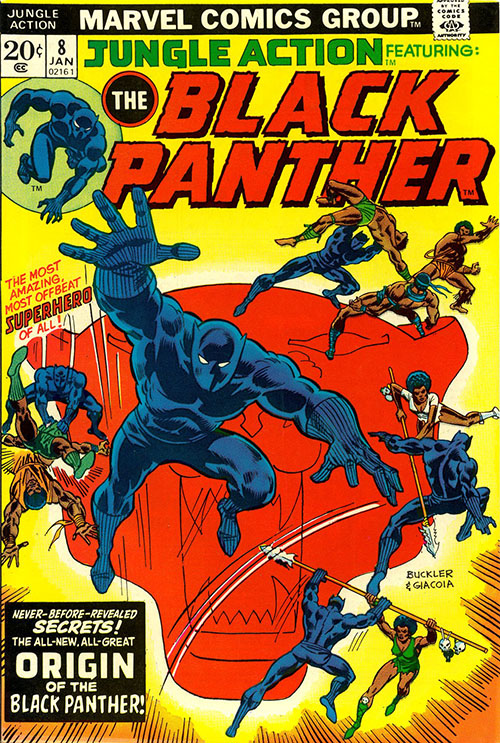
Debuting in 1972, Jungle Action was the domain of adventurers of the wild such as Tharn (“The Magnificent”!) and Lorna (“Queen of the Jungle”). The two Edgar Rice Burroughs-styled, Caucasian characters would be replaced by issue #5 thanks to the intervention of a Marvel proofreader by the name of Don McGregor. McGregor maintained that a title set exclusively in Africa should not feature white protagonists. “Originally Marvel had reprint books during that time period, and one of them was Jungle Action that reprinted 1950s ‘jungle comics’-- essentially white jungle gods and goddesses who came in and saved the native,” McGregor told the School Library Journal back in January. “It was just horrendous material. When the line was being expanded, it was decided they would put Black Panther into Jungle Action”. Ultimately, Marvel editorial agreed, opting to reprint an older story featuring the Black Panther, starting with Jungle Action #5.
The reprinted tale was from Roy Thomas and John Buscema’s The Avengers #62 and contained the debut of longtime Panther adversary “Man-Ape”, a character that has been continuously entangled in controversy due to unintentional racial overtones. “I can understand to some extent complaints of some about the perceived or at least perceivable racial impact of a black man in a gorilla costume,” Thomas acknowledges. “M’Baku was made a Man-Ape because his opponent was the Black Panther…not for any racial reason,” he continues. “But I don’t object to getting rid of the ‘Ape’ imagery just to avoid anyone making hay of it. M’Baku should be a strong foe for T’Challa, and nothing else.”

Beginning with Jungle Action #6, McGregor took over as the writer. What followed was a 13-part epic featuring a mostly Black cast of characters titled “Panther’s Rage.” In a bit of course correction, the story brought T’Challa back to Wakanda and detailed a blatant, unending assault to usurp the king. Throughout, T’Challa is kept on his toes by a revolving door of dastardly characters, in particular, the debuting Eric Killmonger whose presence is immediately felt by Black Panther when the villain bests the hero, lifts the T’Challa over his head, and tosses him off the edge of “Warrior Falls” – a moment recreated decades later in the Black Panther movie.
During this fight -- and throughout his time on Jungle Action -- McGregor narrates the king’s internal distress and then gives voice to T’Challa’s dread as the character experiences a figurative and literal downfall. “[Black Panther] spent a lot of time thinking things through,” Avengers writer Kurt Busiek explains, pointing out how Jungle Action would later impact his take on Black Panther in the late 1990s. “A lot of that may come from the McGregor run for me.”
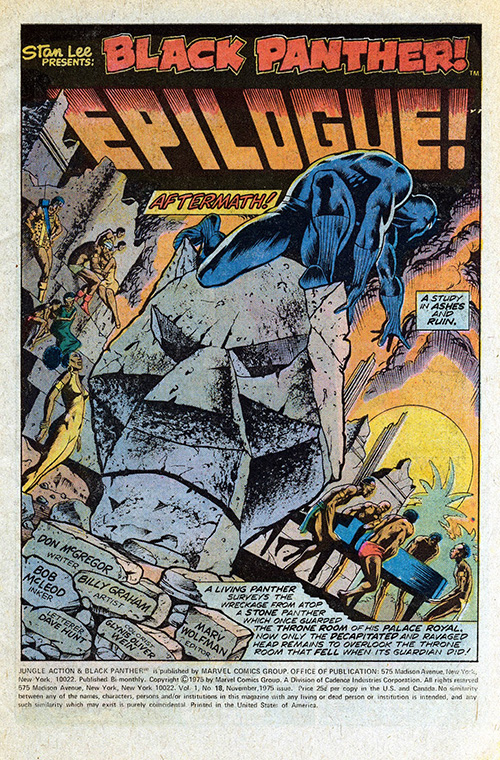
For the first three issues, “Panther’s Rage” was injected with breathless momentum thanks to a close collaboration between McGregor and artist Rich Buckler. Buckler excelled at underlining McGregor’s melodramatic narrations (and Panther’s mid-fight smack-talking) with plenty of over-the-top visualshowever, it was later artist Billy Graham who seemed to take additional care when it came to creating those booming title pages like the one pictured above. Graham would work alongside Don McGregor for the bulk of Jungle Action’s run (issues #6-22). Compared to Buckler, Graham’s art-style was very atmospheric, which likely had plenty to do with the artist’s background as the art director at horror publisher Warren. On Graham’s watch, Panther visually became his namesake: an unpredictable, stealth-like, night stalker -- “a ghost of the forest”.
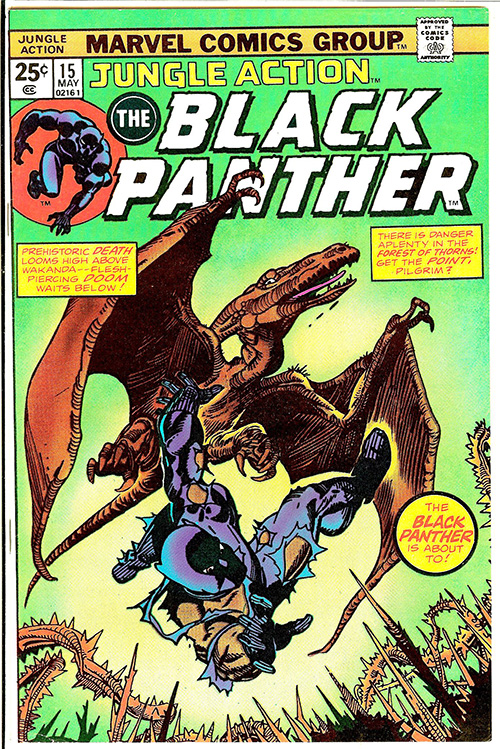
“I was very young…maybe 9 or 10,” recalls artist Ken Lashley about his first experience seeing Black Panther in the ‘70s. “My mother bought me an issue and I was hooked. The artwork was amazing but the story was a bit above me. Maybe it was that the Panther was fighting the K.K.K.,” Lashley laughs. The comic book artist would eventually contribute to building the mythology of Black Panther himself in 2008 with a storyline titled “Deadliest of Species” (and, again, as recently as 2018 with Black Panther Annual #1), but his first run-in with the King of Wakanda actually turned out to be Don McGregor and Billy Graham’s swan song.
It was a multi-issue arc that pitted Black Panther against the KKK, starting with Jungle Action #19. The plot: Panther returns to America to investigate the murder of girlfriend Monica Lynne’s sister. Set in Georgia, things escalate when Panther’s Meet the Parents moment is disrupted by "The Clan" and the Ku Klux Klan (?). As the story continues through issue #21 and #22, readers witness the Klan (with a “K”) getting the jump on T’Challa long enough to tie him to a burning cross. Of course, the joke is on them because the hero’s vibranium suit doesn’t burn.
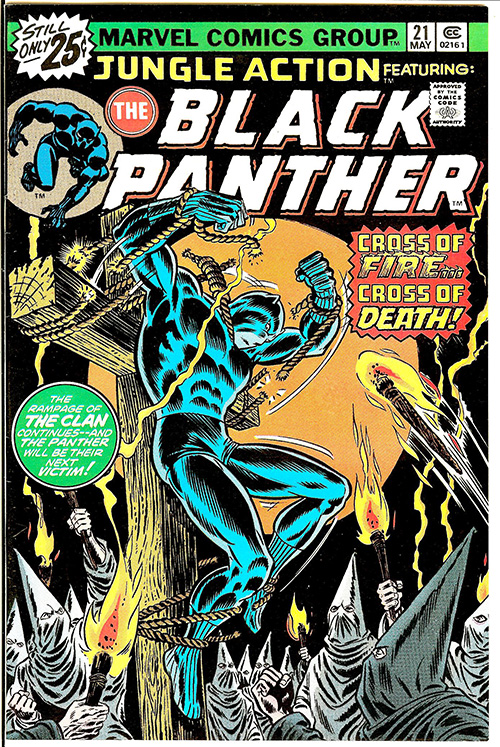
McGregor and Graham’s run would ultimately be cut short and their K.K.K. storyline would have to be resolved later due to a myriad of problems. Some accounts place fault on the creative team for not meeting deadlines. Another account -- as described in Marvel Comics: The Untold Story -- suggests that McGregor’s opposition to editorial interference did the book in. However, low sales may have ultimately been the culprit. “The Black Panther series [Don McGregor] wrote in Jungle Action was never that much of a seller, but I respected all the work that I knew Don was putting in it,” says Roy Thomas who was responsible for putting McGregor on the book in the first place. “He may have felt underappreciated during that period, but he was not,” Thomas goes on to say. “I only wish Rich Buckler and Billy Graham could also be around to bask in a bit of favorable glare.”
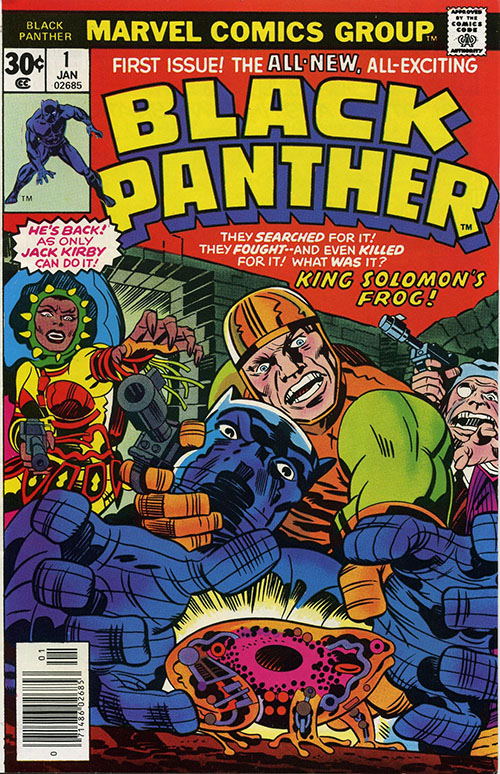
By the end of 1976, Black Panther had lost the only title he’d ever headlined and was back to making guest appearances in other, more popular titles. But only for a moment. In the spring of 1977, Black Panther’s co-creator Jack Kirby returned to Marvel after a seven-year voyage at rival company DC Comics. Unhappy with the creative mandates at DC, Kirby would spend two years at his old stomping grounds before exiting again due to dissatisfaction. During his time at Marvel, however, Kirby would reluctantly take on Black Panther, spinning him more towards the sci-fi pulp adventurer subgenre that was the writer-artist's hallmark. “You go back and read Don McGregor and T’Challa’s this ultimate philosopher-poet, and Jack Kirby has him as the ultimate Kirby guy,” says current Marvel writer Al Ewing. “[T’Challa would be] up to his ears in strange alien gods but never outgunned or outclassed.”
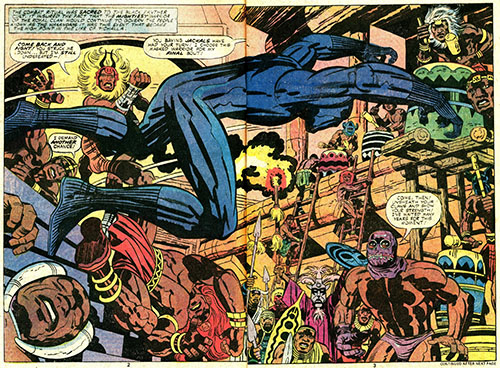
Ewing’s time with Black Panther on 2015’s The Ultimates would mirror Kirby's run in a way. Despite having a few decades between them, both series made Black Panther the “cosmic guy” in order to provide a change of pace. Like much of Jack Kirby’s work from the Silver Age onward, the creator’s “King Solomon’s Frog!” storyline reads like an intersection of extra-terrestrial ideas.
The opening splash of 1977’s Black Panther #1 tosses at readers an unsolved murder mystery, a time-bending brass frog, the reintroduction of Black Panther (now rocking a shimmering vibranium suit), and the debut of his diminutive sidekick with a monocle named “Mr. Little.” Kirby stacks ideas normally reserved for drug-induced hallucinations, and he does it all for the sake of high adventure!
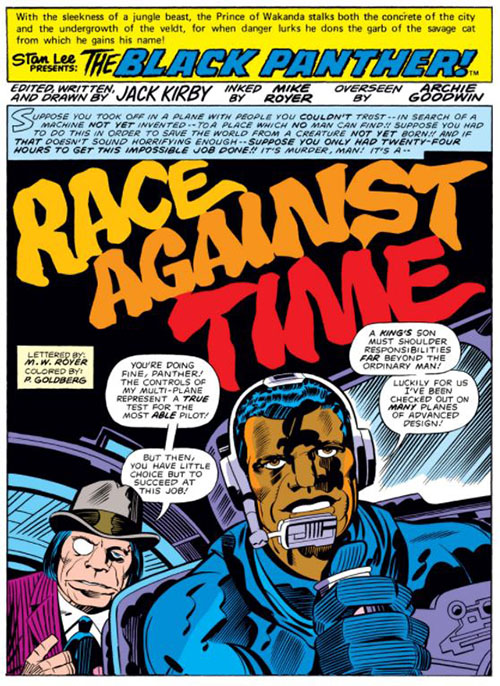
Jack Kirby’s approach was viewed as stodgy and retro when compared to the more self-aware titles of the day, like Steve Gerber’s Howard the Duck. The book also drew comparison to Don McGregor’s more contemporary take on the character in Jungle Action. Now, the short-lived run (12 of its 13 issues were created by Kirby) is viewed as an amusing oddity, one that has come to be appreciated by modern readers and creators like Jason Pearson. “What I really liked more in the Kirby run was he didn’t sound like the other ‘Black’ characters of that time, with their stereotypical speak,” Pearson says. Pearson himself would serve as a Black Panther artist during Marvel’s line-wide Secret Invasion event years later. “Black Panther’s creator Jack ‘King’ Kirby has long passed away and can’t see the fruition of his creations,” Pearson goes on to say, noting that T’Challa is also deemed “King” in the Marvel universe. “The King is dead, long live the king.”

Black Panther entered the 1970s as simply a supporting character. By the end of the decade, he had finally managed to become a solo star – the headlining feature in a gutsy action book and then a headlining character in an over-the-top sci-fi adventure series. These disparate takes reflect the difficulty in defining what version of him appeals to readers and creators. Even further, as we head into the 1980s, T’Challa seems out-of-step with trends in the comic industry. He no longer has a title to call his own and is back to being a supporting player. Marvel hadn’t yet solved the problem of “who is the Black Panther?” and what makes him truly tick.
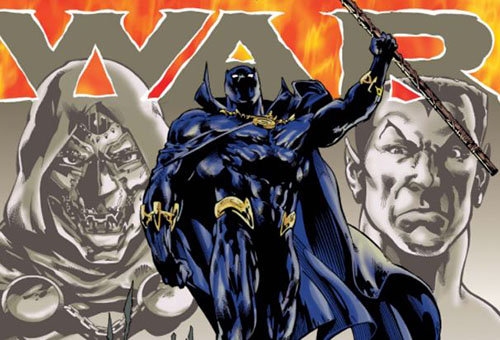
****
Troy-Jeffrey Allen is the Consumer Marketing Digital Editor for PREVIEWSworld.com and Diamond's pop culture network of sites. His comics work includes BAMN, Fight of the Century, and the Harvey Award-nominated District Comics.




